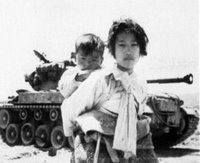That's in the first paragraph of the story. You have to dig a little deeper for the part that qualifies the order:
"If refugees do appear from north of US lines they will receive warning shots, and if they then persist in advancing they will be shot," wrote Ambassador John J. Muccio, in his message to Assistant Secretary of State Dean Rusk.The letter is receiving attention in part because it apparently wasn't found in what was supposedly an exhaustive investigation from 1999 to 2001, after the AP detailed an account of the Army's killing of large numbers of Korean refugees at Nogun-ri. The Muccio letter, declassified in 1982, was dated the same day as the Nogun-ri massacred.
The Muccio letter, which seems to contradict Pentagon accounts of what happened as a bunch of panicky soldiers reacting improperly—and without orders—to a group of refugees who may have had weapons and North Korean operatives among them, is discussed in a new book by American historian Sahr Conway-Lanz, entitled "Collateral Damage." In his book, he argues that, "With this additional piece of evidence, the Pentagon report's interpretation [of Nogun-ri] becomes difficult to sustain."
The WaPo says that the letter "is the strongest indication yet that such a policy existed for all U.S. forces in Korea, and the first evidence that that policy was known to upper ranks of the U.S. government."
The Pentagon concluded that the Nogun-ri shootings, which lasted three days, were "an unfortunate tragedy"..."not a deliberate killing." It suggested panicky soldiers, acting without orders, opened fire because they feared that an approaching line of families, baggage and farm animals concealed enemy troops.
Nogun-ri has been an embarrassment for the American military and anyone who supports strong US-ROK ties. For years, during staunchly pro-American regimes, the survivors at Nogun-ri found it difficult to seek redress. Some groups say hundreds more refugees were killed in later, similar episodes.
According to the WaPo and AP:Muccio's letter indicates the actions of the 7th Cavalry were consistent with policy, adopted because of concern that North Koreans would infiltrate via refugee columns. And in subsequent months, U.S. commanders repeatedly ordered refugees shot, documents show.The Army is standing by the report that was given, but acknowledged that among the millions of documents reviewed, the Muccio letter may have been missed.
 What I don't like about the story is that it appears to be only half the story. The shocking part is at the top, the details later may be missed. Those meeting on the night of July 25, 1950, including US 8th Army top staff officers, Muccio's representative Harold J. Noble, and ROK officials, decided on a policy of air-dropping leaflets telling South Korean civilians not to head south toward U.S. defense lines and of shooting them if they did approach U.S. lines despite warning shots.
What I don't like about the story is that it appears to be only half the story. The shocking part is at the top, the details later may be missed. Those meeting on the night of July 25, 1950, including US 8th Army top staff officers, Muccio's representative Harold J. Noble, and ROK officials, decided on a policy of air-dropping leaflets telling South Korean civilians not to head south toward U.S. defense lines and of shooting them if they did approach U.S. lines despite warning shots.It should also be noted that it is not clear what action was taken as a result of the letter. Dated the same day as Nogun-ri, it may have had nothing to do with the tragedy that happened there.
Billy, the Korean War veteran story-teller I mentioned here, told me of some of what the US military was up against in the early days. Refugees were streaming south — staying north mean some or all would die. But the refugees were blocking their saviors from heading to the fighting, to meet those who would do them harm.
Billy told me of how the tanks would fire over the columns of refugees who were blocking the roads. That would get most to move off the road, at least for a while. Eventually, he said, it would be necessary to do this again.
The refugees were moving, moving, moving, because to do otherwise meant dying. We know of the tragic story of the refugees moving across the Han River Bridge as the retreating ROK and US forces were setting to blow it up to prevent the North Koreans from moving south of the river. But the refugees wouldn't get off. At some point, the horrific decision had to be made to sacrifice those still on the bridge in order to save many more lives.
I am not trying to justify anything that happened there. I really don't know what happened. North Koreans reportedly really had infiltrated many columns of refugees, which put all of them at risk. In times of war, it's hard to know who the enemy is and who isn't, but ultimately, much or all of the blame lies with Kim Il-Sung and the North Koreans, who perpetrated the war in the first place and utilized such tactics in a way that gave the ROK and its allies nothing but Hobson's choices.

Photo: refugees heading south
No comments:
Post a Comment
Share your thoughts, but please be kind and respectful. My mom reads this blog.